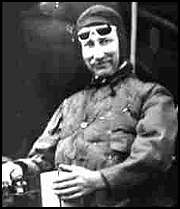George R. Lawrence
George Raymond Lawrence (born February 24, 1868 in Ottawa , Illinois , † December 15, 1938 ) was a photographer from Northern Illinois. He grew up in Kankakee County and moved to Chicago in 1890 , where he made an invention for his employer to attach iron rims to wooden wheels. In 1891 he began working as a portrait photographer. From 1896 he had the studio, which he had previously shared with a business partner, to himself. He improved the mixture of the fluorescent powder for flash lamps based on magnesium in such a way that it shone brighter and burned off with less smoke, so that he was also called the father of flash photography .
Around 1900 he built the largest camera in the world in Chicago. The "Mammut" weighed 600 kg and was served by 15 people. He created them to be used in a picture for the Chicago & Alton Railroad Co. that was shown at the World's Fair in Paris. He also took aerial photos of hot air balloons and of kites using electrically remote-controlled cameras . He became famous for his panorama picture of earthquake-destroyed San Francisco from 1906. For this shot, the camera was raised to an altitude of about 600 m by a chain of kites. Lawrence called his kite chain "Captive Airship", literally translated: Fetter airship.
Web links
- George R. Lawrence biography on the Library of Congress website
- Sven Stillich: Extreme photographer George Lawrence: The man with the giant snaps , on one day , contemporary history portal from Spiegel Online, April 11, 2013
- George Raymond Lawrence at camera-wiki.org
Individual evidence
- ↑ A city in ruins: Stunning photo that captures devastation in San Francisco after earthquake of 1906 . In: Mail Online . ( dailymail.co.uk [accessed November 24, 2018]).
- ↑ http://robroy.dyndns.info/lawrence/kitelines97.html
| personal data | |
|---|---|
| SURNAME | Lawrence, George R. |
| ALTERNATIVE NAMES | Lawrence, George Raymond |
| BRIEF DESCRIPTION | American photographer |
| DATE OF BIRTH | February 24, 1868 |
| PLACE OF BIRTH | Ottawa , Illinois |
| DATE OF DEATH | December 15, 1938 |


